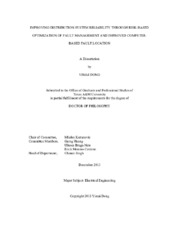| dc.contributor.advisor | Kezunovic, Mladen | |
| dc.creator | Dong, Yimai | |
| dc.date.accessioned | 2014-05-13T17:10:34Z | |
| dc.date.available | 2015-12-01T06:31:21Z | |
| dc.date.created | 2013-12 | |
| dc.date.issued | 2013-11-07 | |
| dc.date.submitted | December 2013 | |
| dc.identifier.uri | https://hdl.handle.net/1969.1/151690 | |
| dc.description.abstract | Utilities of distribution systems now are under the pressure of improving the reliability of power supply, not only from the urge to increase revenue, but also from requirements of their customers and the Independent Service Organization (ISO)’s regulation on power quality. Optimization in fault management tasks has the potential of improving system reliability by reducing the duration and scale of outages caused by faults through fast fault isolation and service restoration.
The research reported by this dissertation aims at improving distribution system reliability through optimized fault management. Three questions are explored and answered: 1) how to establish the cause-and-effect relationship between fault management and system reliability; 2) how can individual fault management tasks benefit from the newly emerged smart grid technologies; and 3) how to improve the overall performance of fault management under new operation condition.
Optimization of the fault management is done through minimizing a risk function representing system reliability. The improvement in system reliability is approached in following steps: 1) a risk function consists of distribution reliability indices is defined as the criterion for system reliability; 2) a new fault location method is proposed first that can accurately locate the faults with the assistance of voltage-sag-measurements from system-wide Intelligent Electronics Devices (IEDs); 3) the fault management task of field inspection is optimized using the risk function and the probability model of the true fault location established using results from fault location; 4) the decision making on the execution of during-fault service restoration is optimized through Monte Carlo simulation; 5) the optimized fault management is utilized in processing the faults and the improvement in system reliability is assessed by reduction of costs associated with these faults.
The proposed optimization is demonstrated on a realistic distribution system. The stochastic model of faults in the system is built with consideration of normal and extreme weather conditions. Results show that the proposed optimization is capable of improving system reliability by reducing the mean and variance of outage cost calculated over the simulated years. | en |
| dc.format.mimetype | application/pdf | |
| dc.language.iso | en | |
| dc.subject | Distribution system | en |
| dc.subject | reliability | en |
| dc.subject | outage | en |
| dc.subject | fault management | en |
| dc.subject | fault location | en |
| dc.subject | optimization | en |
| dc.subject | risk-analysis | en |
| dc.title | Improving Distribution System Reliability Through Risk-base Doptimization of Fault Management and Improved Computer-based Fault Location | en |
| dc.type | Thesis | en |
| thesis.degree.department | Electrical and Computer Engineering | en |
| thesis.degree.discipline | Electrical Engineering | en |
| thesis.degree.grantor | Texas A & M University | en |
| thesis.degree.name | Doctor of Philosophy | en |
| thesis.degree.level | Doctoral | en |
| dc.contributor.committeeMember | Huang, Garng | |
| dc.contributor.committeeMember | Braga-Neto, Ulisses | |
| dc.contributor.committeeMember | Moreno-Centeno, Erick | |
| dc.type.material | text | en |
| dc.date.updated | 2014-05-13T17:10:34Z | |
| local.embargo.terms | 2015-12-01 | |


